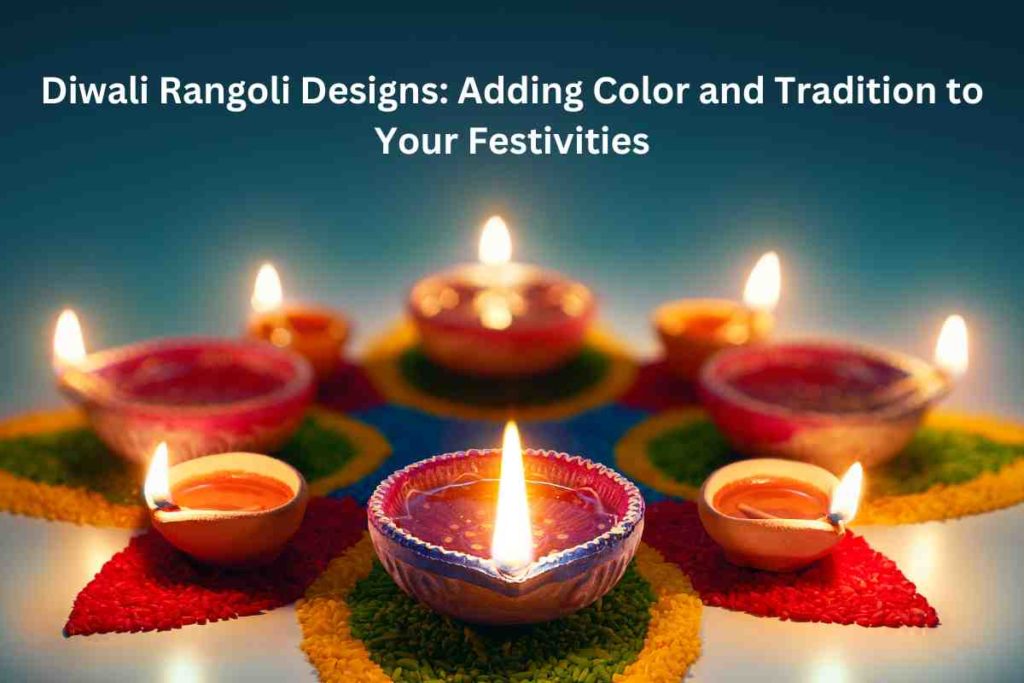Diwali Rangoli Designs: Diwali, also known as the Festival of Lights, is a joyous occasion celebrated by millions of people across the world. One of the most captivating and traditional aspects of Diwali is the art of creating Rangoli designs. These intricate and colorful patterns not only enhance the beauty of your home but also hold deep cultural significance. In this article, we’ll explore the enchanting world of Diwali Rangoli designs, offering you a glimpse into their history, significance, and inspiring ideas to adorn your home during this auspicious festival.
Introduction to Diwali
Diwali, also known as Deepavali, signifies the triumph of light over darkness and good over evil. It’s a time when families come together to celebrate with prayers, delicious food, and the lighting of lamps. Rangoli, created at the entrance of homes, is a way to welcome guests and invoke blessings from the deities.
The Art of Rangoli
2.1. The Historical Significance
Rangoli has a rich history dating back to ancient India. It was initially created as a way to feed ants and small insects with the rice flour used to make these patterns. Over time, it evolved into a form of art that reflects our cultural heritage.
2.2. Materials Used in Rangoli
Traditional Rangoli designs use materials like rice flour, colored sand, flower petals, and vibrant spices to create a visual spectacle. Modern renditions also incorporate chalk, colored powders, and even eco-friendly materials to reduce environmental impact.
Traditional Rangoli Designs
3.1. Diya Patterns
One of the most popular traditional Rangoli designs is the Diya pattern. These intricate patterns often feature oil lamps, symbolizing the victory of light over darkness.
3.2. Peacock Motifs
Peacock-themed Rangoli designs are a symbol of grace and beauty. They are characterized by the intricate detailing of the peacock’s feathers.
3.3. Lotus Designs
The lotus holds immense significance in Hinduism. Lotus-themed Rangoli designs are known for their elegance and spiritual undertones.
Contemporary Rangoli Trends: Diwali Rangoli Designs
4.1. Geometric Patterns
Modern Rangoli artists often experiment with geometric shapes and symmetry to create visually stunning designs.
4.2. Floral Extravaganza
Floral Rangoli designs incorporate a variety of colorful flowers to form intricate and fragrant patterns.
4.3. Fusion of Cultures
In today’s globalized world, Rangoli designs often fuse traditional Indian motifs with international design elements, creating a unique blend of cultures.
Steps to Create a Stunning Rangoli
5.1. Preparing the Base
Start by cleaning the area and creating a smooth base for your Rangoli. Traditionally, this is done by sprinkling rice flour or chalk to form the outline.
5.2. Sketching the Design
Use chalk or a pencil to sketch your chosen design lightly. This step helps you maintain symmetry.
5.3. Adding Colors
Fill in the design with vibrant colors. You can use various materials like colored powders, flower petals, or even colored sand.
5.4. Adding Final Touches
Once the colors are filled, add decorative elements like mirrors, candles, or diyas to enhance the beauty of your Rangoli.
Rangoli Competitions: Diwali Rangoli Designs
Many communities host Rangoli competitions during Diwali, fostering creativity and friendly competition among neighbors. Participating in these events can be a great way to connect with your community.
Significance of Rangoli in Diwali
Rangoli is not just about aesthetics; it plays a significant role in Diwali traditions.
Rangoli and Spiritual Connection
Creating a Rangoli is considered a spiritual endeavor, invoking positive energy and blessings into your home.
Preserving the Environment
In recent years, there has been a growing focus on eco-friendly Rangoli materials to reduce the environmental impact of this art form.
Rangoli and Family Bonding
Creating Rangoli together as a family can be a heartwarming experience that strengthens bonds and creates lasting memories.
Tips for Beginners
If you’re new to Rangoli, start with simpler designs and gradually work your way up to more intricate patterns.
Rangoli and Festive Foods
Rangoli and food are inseparable during Diwali. Families often prepare traditional sweets and snacks while creating Rangoli.
Rangoli in the Digital Age
In the age of technology, Rangoli designs have found a place on social media, inspiring creativity worldwide.
Personalizing Rangoli
Make your Rangoli designs unique by infusing them with your personal touch and creativity.
Conclusion: Diwali Rangoli Designs
Diwali Rangoli designs are not just an art form; they are a reflection of our cultural heritage and a symbol of the festive spirit. As you prepare to celebrate Diwali, consider creating a beautiful Rangoli at your doorstep to welcome light and positivity into your life.
FAQs: Diwali Rangoli Designs
Question 1: What is the significance of Rangoli during Diwali?
Answer:- Rangoli symbolizes the welcoming of guests and the invocation of blessings during the Diwali festival.
Question 2: Can I use eco-friendly materials for Rangoli?
Answer:- Absolutely! Using eco-friendly materials like flower petals and colored sand is a great way to reduce your environmental footprint.
Question 3: Are there any online resources for Rangoli designs?
Answer:- Yes, you can find a plethora of Rangoli design ideas and tutorials online to inspire your creativity.
